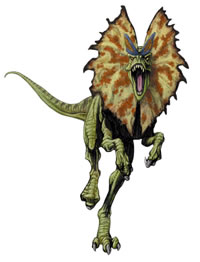
“Double-crested reptile”, was discovered in 1942 in Monument Valley in the Navajo country, Arizona, by native Jesse Williams. Based on these remains, which came from the Kayenta Formation, it was described in 1954 by Sam Welles as a new species of Megalosaurus, before new remains revealed it was a new animal. Welles gave it a new description, and name, in 1970.
Dilophosaurus lived during the Hettangian or Sinemurian stages of the Early Jurassic, about 200 to 190 million years ago. It was 6 meters (20ft) in length, over 1.8 meters (6ft) in height at the hips and 1000 pounds (454kg) in weight.
It belonged to the Dilophosauridae, a group of medium-sized early theropods that also included Cryolophosaurus, Dracovenator, and Zupaysaurus. Material for Dilophosaurus includes a number of specimens of varying degrees of completeness and ages, ranging from scattered fragments of an infant, to the incomplete subadult holotype specimen, to an incomplete adult specimen which was the first to preserve the distinctive crests, and more. The large crests for which it was famous may have been used for sexual display or intraspecific recognition, and would have been brightly colored. Several specimens have been discovered together and have been interpreted as evidence of group behavior, though this has been contested by other researches, leaving it open to debate. In addition, resting traces attributed to Dilophosaurus have been used to shed light on dinosaur posture, and track types from the Kayenta Formation have been attributed to Dilophosaurus.
It is heavily unlikely the real-life Dilophosaurus was able to spit venom.

